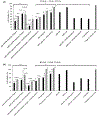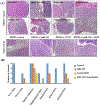Dual delivery nanoscale device for miR-345 and gemcitabine co-delivery to treat pancreatic cancer
- PMID: 30576747
- PMCID: PMC6379902
- DOI: 10.1016/j.jconrel.2018.12.031
Dual delivery nanoscale device for miR-345 and gemcitabine co-delivery to treat pancreatic cancer
Abstract
A polymeric dual delivery nanoscale device (DDND) was designed for combined delivery of microRNA (miR-345) and gemcitabine (GEM) to treat pancreatic cancer (PC). This temperature and pH-responsive pentablock copolymer system was able to restore miR-345, making xenograft tumors more susceptible to GEM, the standard therapy for PC. Restoration using DDND treatment results in sonic hedgehog signaling down regulation, which decreases desmoplasia, thereby resulting in improved GEM perfusion to the tumor and better therapeutic outcomes. The release of miR-345 and GEM could be tuned by using the DDND in the form of micelles or in the form of thermoreversible gels, based on polymer concentration. The DDNDs enabled miR-345 stability and sustained co-release of miR-345 and GEM, thereby facilitating dose-sparing use of GEM. Further, enhanced in vitro cellular uptake due to amphiphilic character, and endosomal escape because of the cationic end blocks led to efficient transfection with DDNDs. The combined DDND treatment enabled efficient reduction in cell viability of Capan-1 and CD18/HPAF cells in vitro compared with either GEM or miR-345 treatment alone. Mice carrying xenograft tumors treated with DDNDs carrying both miR-345 and GEM combination therapy displayed reduced tumor growth and less metastasis in distant organs compared to individual drug treatments. Immunohistochemical analysis of the xenograft tissues revealed significant down regulation of desmoplastic reaction, SHH, Gli-1, MUC4, and Ki67 compared to control groups.
Keywords: Gemcitabine; Nanoscale delivery; Pancreatic cancer; miR-345.
Copyright © 2018 Elsevier B.V. All rights reserved.
Figures








Similar articles
-
Chemosensitization and inhibition of pancreatic cancer stem cell proliferation by overexpression of microRNA-205.Cancer Lett. 2017 Aug 28;402:1-8. doi: 10.1016/j.canlet.2017.05.007. Epub 2017 May 20. Cancer Lett. 2017. PMID: 28536008 Free PMC article.
-
UTMD-Promoted Co-Delivery of Gemcitabine and miR-21 Inhibitor by Dendrimer-Entrapped Gold Nanoparticles for Pancreatic Cancer Therapy.Theranostics. 2018 Feb 14;8(7):1923-1939. doi: 10.7150/thno.22834. eCollection 2018. Theranostics. 2018. PMID: 29556365 Free PMC article.
-
Micelle Mixtures for Coadministration of Gemcitabine and GDC-0449 To Treat Pancreatic Cancer.Mol Pharm. 2016 Jun 6;13(6):1822-32. doi: 10.1021/acs.molpharmaceut.5b00971. Epub 2016 Apr 27. Mol Pharm. 2016. PMID: 26981724 Free PMC article.
-
Acquired and intrinsic gemcitabine resistance in pancreatic cancer therapy: Environmental factors, molecular profile and drug/nanotherapeutic approaches.Environ Res. 2024 Jan 1;240(Pt 2):117443. doi: 10.1016/j.envres.2023.117443. Epub 2023 Oct 18. Environ Res. 2024. PMID: 37863168 Review.
-
Liposomal nanostructures for Gemcitabine and Paclitaxel delivery in pancreatic cancer.Eur J Pharm Biopharm. 2023 Nov;192:13-24. doi: 10.1016/j.ejpb.2023.09.014. Epub 2023 Sep 25. Eur J Pharm Biopharm. 2023. PMID: 37758121 Review.
Cited by
-
Physically stimulus-responsive nanoparticles for therapy and diagnosis.Front Chem. 2022 Sep 14;10:952675. doi: 10.3389/fchem.2022.952675. eCollection 2022. Front Chem. 2022. PMID: 36186605 Free PMC article. Review.
-
RNAi-Based Approaches for Pancreatic Cancer Therapy.Pharmaceutics. 2021 Oct 8;13(10):1638. doi: 10.3390/pharmaceutics13101638. Pharmaceutics. 2021. PMID: 34683931 Free PMC article. Review.
-
Multistage targeting and dual inhibiting strategies based on bioengineered tumor matrix microenvironment-mediated protein nanocages for enhancing cancer biotherapy.Bioeng Transl Med. 2022 Jan 5;7(2):e10290. doi: 10.1002/btm2.10290. eCollection 2022 May. Bioeng Transl Med. 2022. PMID: 35600646 Free PMC article.
-
Mapping the function of MicroRNAs as a critical regulator of tumor-immune cell communication in breast cancer and potential treatment strategies.Front Cell Dev Biol. 2024 Apr 25;12:1390704. doi: 10.3389/fcell.2024.1390704. eCollection 2024. Front Cell Dev Biol. 2024. PMID: 38726321 Free PMC article. Review.
-
Silencing of long non-coding RNA SNHG15 suppresses proliferation, migration and invasion of pancreatic cancer cells by regulating the microRNA-345-5p/RAB27B axis.Exp Ther Med. 2021 Nov;22(5):1273. doi: 10.3892/etm.2021.10708. Epub 2021 Sep 7. Exp Ther Med. 2021. Retraction in: Exp Ther Med. 2025 Jul 07;30(3):169. doi: 10.3892/etm.2025.12919. PMID: 34594410 Free PMC article. Retracted.
References
-
- Siegel RL, Miller KD, Jemal A, Cancer statistics, 2016, CA: a cancer journal for clinicians, 66 (2016) 7–30. - PubMed
-
- Matsuno S, Egawa S, Fukuyama S, Motoi F, Sunamura M, Isaji S, Imaizumi T, Okada S, Kato H, Suda K, Nakao A, Hiraoka T, Hosotani R, Takeda K, Pancreatic Cancer Registry in Japan: 20 years of experience, Pancreas, 28 (2004) 219–230. - PubMed
Publication types
MeSH terms
Substances
Grants and funding
LinkOut - more resources
Full Text Sources
Other Literature Sources
Medical
Research Materials

